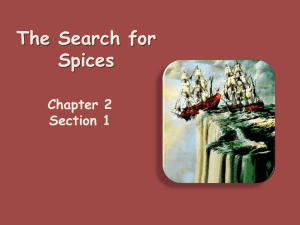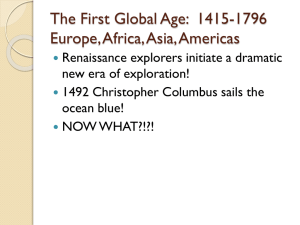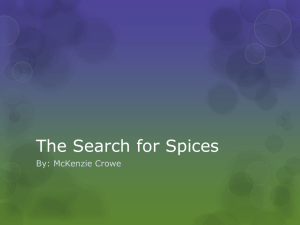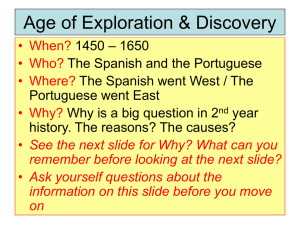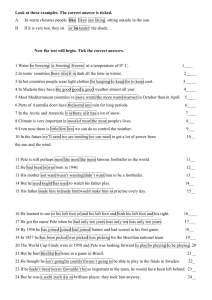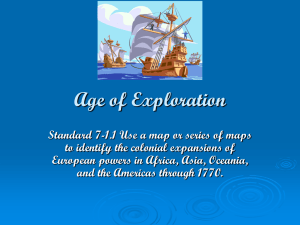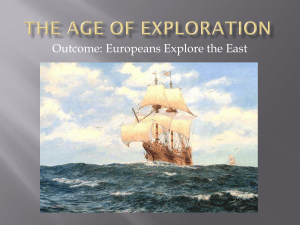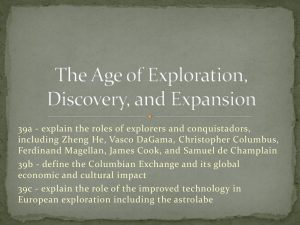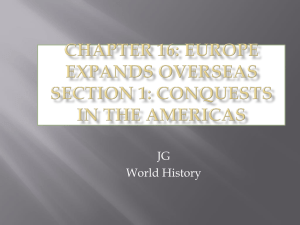Explorers
advertisement
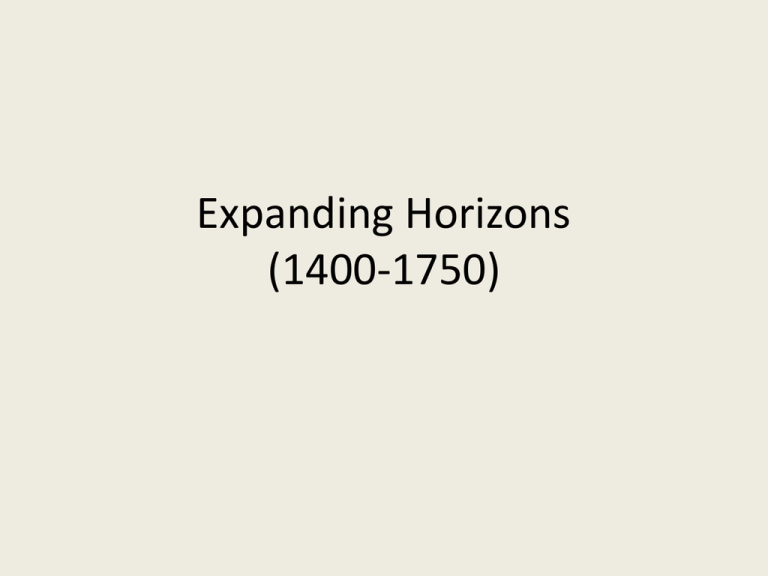
Expanding Horizons (1400-1750) The Quest for Spices • Europe of 1300’s had depended on Asia and India for spices • Uses – To preserve meats – For perfumes, cosmetics, and medicines Spice trade is controlled by Arabs and Venetian merchants • Chinese and Indian merchants sold spices to Arab merchants, who shipped the cargoes overland to Europe • Arabs amass huge fortunes Cut out the “Middle Man” • Europeans look for direct trade routes • Land routes are too risky • Look for sea routes • Motivations that lead Europeans into an era of exploration Era of Exploration Why explore? • • • • Profit through direct trade with Asia Christians want to stop the spread of Islam Spread missionary work Learning and imagination Technology of Exploration • The Compass-Chinese in Origin • By 1100 sailors used the astrolabe – determines the altitude of the sun or other heavenly bodies • Perfected by the Arabs • Maps-Inaccurate at the time but constantly improving • Cartographers—mapmakers • Skilled improved by 1300 become accurate of Mediterranean coastline • Egyptian astronomer—Ptolemy works appear in Europe • He introduced the grid system-Longitude and Latitude • Construction of ships – Late 1400’s shipwrights outfitted ships with triangle-shape lateen sails (got from Arabs) makes it possible to sail against the wind – Multiple masts vs. just 1 – Moved rudders from the ship’s side to the stern(back) made ships more maneuverable • Larger ships –Were built called Caravels –Carry more cargo –But could venture up shallow inlets Portugal Leads the Way • 1st to venture out of Atlantic Ocean • 1420-1580—goes down African coast— looking for a route to Asia • Prince Henry the Navigator – Son of King John I of Portugal – Not a sailor—never made an ocean voyage – Brought together: mapmakers, mathematicians, and astronomers to study navigation Prince Henry the Navigator and Portugal • Sponsored many Portuguese exploration –In the Atlantic (West) –Africa (South) –Discovered the Azores, Madeira Islands and Cape Verde Portuguese Empire and Explorers • Bartholomeu Dias • 1487-Leaves Portugal • 1488 - discovers the tip of Africa • Named: The Cape of Good Hope • Can now reach Asia by sailing around Africa Vasco da Gama Sailed from Portugal to India (took 10 months) Spain’s Quest for Riches • 1400’s end long wars with the Moors • King Ferdinand and Queen Isabella • Italian navigator—Christopher Columbus (1492)—wanted to reach India by sailing West • Other European Rulers declined to finance Columbus’ voyages Wedding Portrait of Ferdinand and Isabella Columbus meeting with Ferdinand and Isabella Columbus sails from Spain • August, 1492 sails with three ships (Nina, Pinta, and Santa Maria) • Calculated the trip to be 700 leagues (2,200miles) • Much longer-crew gets nervous-false sightings of land- crew wants to turn back-MutinyColumbus agrees to turn back in 3 days • After midnight on the 2nd day the expedition sights land • Sets foot on the Island of Bahamas • Columbus believes he is off the west coast of India – “Indians” • Spent the next 3 mos. Exploring the island (present day Haiti/Dominican Republic and Cuba)—looking for GOLD Columbus Title • Ferdinand and Isabella give the title: “Admiral of the Oceans Sea, Viceroy and Governor of the Islands he hath discovered in the Indies” Amerigo Vespucci • Stated Columbus discovered a New World • In honor of him the name “America” begins to appear on maps Dividing the World • Spain and Portugal want to protect their claims and turn to the Pope for help • 1493 Pope draws the Line of Demarcation—an imaginary line running down the middle of the Atlantic from the North Pole to the South Pole • Spain controls all lands West • Portugal -- East Treaty of Tordesillas • (TAWR-duh-See-yahs) • Agree to move the line of demarcation more WEST • Divides all of the lands between the 2 countries Line of Demarcation Voyage of Magellan Portuguese Soldier Magellan • Discovered the Tip of South America—Strait of Magellan • Then sails to the Pacific Ocean (lost ships, killed Captains, Mutiny on the trip) • Sailed for 4 more months reached the Philippines • Magellan is killed in a small skirmish between a local chief and his enemy-rest of crew escapes • Crew sails back to Spain • Voyage last 3 years (1519-1522) • The last ship of Magellan’s reaches Spain-ship is the Victoria—lands in Seville, Spain • THIS IS THE 1ST CIRCUMNAVIGATION of the globe Results of Magellan • Proved that the world was round • The oceans are connected • Columbus did not discover a route to Asia Overseas Empires • Portugal and Spain • Portugal: Main interest lay in Africa and Asia— TRADE • Eager to trade with India • Less than 6 mos. After the return of Vasco de Gama, 13 ships were dispatched to India— Spices—Led by Pedro Alvares Cabral— defeated Muslims in a trade war (bloody) Portugal • Now control the trade routes • Expand trade to ports in China and Japan • They also colonized Brazil –Grew sugarcane, tobacco, coffee and cotton –Brought slaves from Africa Spain • Conquistadors • Hernan Cortes—left Cuba for Mexico in 1519 • Sailed with 11 ships and 500 men • Landed and marched towards Tenochtitlan The Aztec capital Cortes Montezuma II • Aztec ruler • Aztecs thought the Spanish as, “supernatural creatures riding on hornless deer, preceded by wild animals on leashes, dressed in iron.” • Believed that the Spanish had come to fulfill a legendary prophecy—he offers gold • Spaniards see the riches of the city • Spanish slaughter 50,000Aztecs • European diseases killed hundred of thousands • Within 3 years Cortes ruled Mexico Francisco Pizarro • • • • Invaded Incas (present day Peru) Captures Inca leader Atahualpa (AH-tuh-WAHL-puh) Pizarro has 100 men—he slaughters 2,000 of Atahualpa’s body guards • Atahualpa– fill room with gold in 3 mos. • Doesn’t accomplish it • Pizarro kills him—chokes vs. burns Pizarro Building an Empire • 1600’s Spanish Empire includes • West Indies, Central America, much of South America and parts of U.S. 2 Goals in Americas • Exploit wealth • Convert natives to Christianity – Believed that Natives were their subjects— entitled to land must abide by Spanish Law However: They were abused by plantation owners, destroyed their temples, and banned their religions • Disease was their worst enemy • Locked immunity to: small pox, measles, and influenza • In the first 50 years of Spanish control – Inca population fell from 7 million to 1 million – Spanish bring more enslaved Africans over as laborers Most valuable export—Silver and Gold Crown keeps 1/5 of every shipment Pirates cut into profits Colonies of the Netherlands • Late 1500’s the Dutch win their Independence from Spain • Dutch Middle Class see commerce the key to survival • Dutch efficient sailors – Carry more cargo with smaller crews – Why is this good? Amsterdam • Becomes the world’s largest commercial city • Enjoy the highest standard of living Dutch Trading • 1602 The Dutch East India Co. is chartered • 1619 Co sets up headquarters at Batavia on the island of Java (Indonesia) • Control island trade in: sugar, spices, coffee and tea • By 1621 push the Portuguese and English out of Asia—Muslims were pushed out as well Indonesia Dutch Explorers • Henry Hudson • Sets out for N. America—claims land along the Atlantic coast • In 1621 the governments charters the Dutch West Indies Co. to establish colonies in America • New Amsterdam on Manhattan Island at the mouth of the Hudson River • 1652-establish colonies in Africa • Dutch farmers known as Boers settled at the Cape of Good Hope • By 1700’s Dutch power declines—English had emerged as Europe’s leading maritime nation French and English Colonies • France • 1524-Giovanni da Verrazano (Italian) hired by the French in order to find a Northwest passage to Asia—NO SUCCESS • 10 years later • 1534-Jaques Cartier sails up the St. Lawrence River to present day Montreal (claims much of Eastern Canada for France) • 1608-Samuel de Champlain founded Quebecthe 1st permanent settlement in America for the French • 1673-Missionaries Jacques Marquette and Louis Joliet explore the Mississippi Valley • Robert Cavalier A.K.A> Sueur de La Salle claim the entire inland region surrounding the Mississippi River for France • French send Jesuits missionaries to convert the Native Americans • French explorers trade with Native Americans • French also set-up colonies in the West Indies England • 1497-Henry VIII commissions Italian John Cabot to explore the coast of Newfoundland • Giving English the claim to the Americas • 1500’s English sea captains harass the Portuguese and Spanish—become Privateers or Pirates • 1580’s Francis Drake-1st Englishman to circumnavigate the globe-also a pirate English Trading • 1600 English found the English East Indies Co. • Chartered by Queen Elizabeth I • Settled on the island of Jamaica, Bahamas, and Barbados • 1640-English introduce sugarcane plantations to the island – Worked by slave labor – Made 3x’s more profit than tobacco • 1606- The Virginia Co. of London—sent expeditions to America to search for gold and silver • The following year the Co. founded the 1st permanent English settlement-Jamestown • A group of religious dissenters calling themselves Pilgrims founded a second colony Plymouth—present day Massachusetts Slave Trade • In the 1600’s the colonies of the America’s based their economies on agricultural products that required intensive labor • Sugar, tobacco, coffee, and mining Triangular Trade • Ships sailed the legs of the triangle formed by Europe, Africa, and the Americas • In European ports ship carried: manufactured goods (knives, swords, guns, clothes, rum) • West Africa: traded enslaved Africans bought from local rulers • America: Enslaved Africans brought for laborsold and money used to purchase sugar, molasses, cotton, and tobacco • Ships returned to Europe to sell goodscompleting the triangle The Middle Passage • Name given to the ordeal an enslaved person’s journey from the West coast of Africa to the lands of the Americas • Slave traders packed the ships as tightly as possible with their “human cargo” • Occupied a space of 4 to 5 feet high to 2-3 feet wide • Chained together-they could neither fully stand-up nor lie down • Lived in darkness and stifling heat • Trip took 5-12 weeks • Estimated range of Africans brought to the Americas 10-24 million • 1 in 5 who began the trip did not survive • Psychological torment may have been worse than physical—some Africans jumped overboard, some refused to eat (suicide) An Enslaved Person’s Life • Face the slave auction—dehumanizing • Examined and prodded • Most worked as laborers – Clearing land – Hoeing – Planting – Weeding – Harvesting • The work is hard and the hours are long • Life expectancy was short • Many Europeans believed that Africans were physically suited to hard labor, especially in hot, humid climates. The enslaved people were viewed as nothing more than a unit of labor to exploit for profit. Resistance • Many enslaved people take action to gain their freedom • Some fled and started their own free communities • Mass Rebellion was the ultimate weapon – Slaves out-numbered free populations – Most rebellions take place in the Caribbean – Carried out attacks on plantations, burned crops and murdered their owners Saint Dominique • Only successful uprising was in the Frenchruled island of Saint Dominique • Rebellion in 1790’s leads to a proclamation of independence in 1804 • Haiti Changing Ways of Life • The Commercial Revolution • With a growing economy—Europe expands its business methods in order to facilitate profit from world trade • By 1600’s the nation has replaced the city and village now compete for markets and goods • New Business: Investing money=venture capitalism • This becomes known as the Commercial Revolution New Business Methods • Overseas trading Ventures • Risky • Had to raise money to pay for supplies and goods • Hire a captain and crew • Often took several years—the trips Finance methods • 1st turn to Bankers to finance—Medici’s of Florence • By 1600’s Chartered Government Banks replace wealthy families – Bank accept deposits – Charge and give interests – Bank notes and checks—large payments of heavy coins a thing of the past – Exchange currencies—now have exchange rates • Joint Stock Companies – Raise money for ventures – Sold stock – Make profits in the risk of trading voyages • Entrepreneurs – Combined money, ideas, raw materials, and labor to make goods and profit – Take risk and get reward – Bring products from conception to sale How European Countries Gain Wealth • Mercantilism- a theory of national economic policy that states power depends on its wealth. • Goal of every nation is to become as wealthy as possible • Bullion- gold and silver---can measure wealth of a nation by this • Balance of trade-favorable by exporting more goods than importing • Government encourage manufacturing by setting tariffs and taxes on imports and exports Social and Religious Trends • Population in Europe – 1450 55 million – 1650 100 million Why the increase? Trade/higher standard of living new foods from the Americas thought potatoes caused leprosy • Many cases the merchant class exceeded the nobility in wealth • Peasants lives did not change that much • Religious values emphasized the Value of Work • Law: It’s a crime not to work • Some government relief to the “worthy poor” • A strong nation needs healthy citizens for work and soldiers Overseas Colonies • Became an outlet for surplus population • Why people left for colonies – Poor – Criminals – Social Outcasts – Volunteers seek wealth – Wars – Religious persecution
